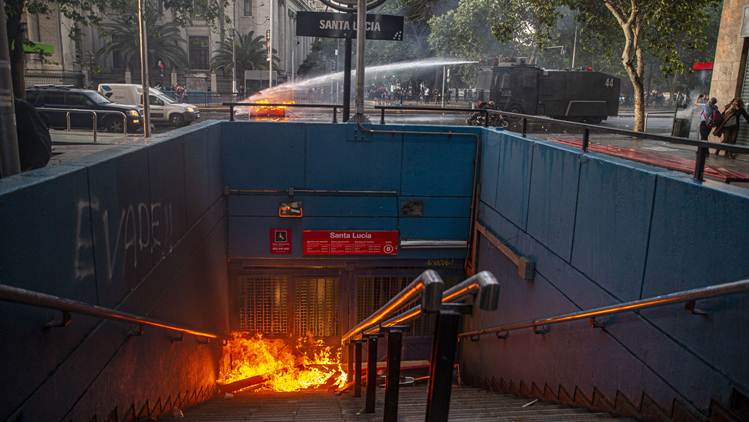Explained: Why are people in rich cities across the world protesting?
Paris, Hong Kong, Santiago — Growing inequalities and a deepening lack of trust in the fairness of their governments could be culprits, believes noted economist Jeffrey Sachs.
 Chile protests: Demonstrators take part in a protest against the increase in the subway ticket prices in Santiago on October 18, 2019 (Reuters Photo: Carlos Vera)
Chile protests: Demonstrators take part in a protest against the increase in the subway ticket prices in Santiago on October 18, 2019 (Reuters Photo: Carlos Vera)
On the face of it, the widespread and intense protests taking place in Chile’s capital, Santiago, do not make sense. Why would citizens of one of the most the wealthiest cities (per capita GDP is over $15,000; India’s per capita GDP is just over $2,100) in Latin America drop everything in their normal life and start rioting in the streets for days on end to remonstrate a marginal hike of just 4% in the public transport fares?
Events turned so ugly that the country declared a state of emergency in the capital on October 18 — and this was extended to include other areas such as Valparaiso, Concepcion, La Serena, Coquimbo and Rancagua as protests spread. All aspects of normal life have been disrupted and the death toll has gone into double digits.
However, Santiago is not the first city that has seen violent protests in the recent past. In November last year, Paris saw massive anti-government protests by the so-called “yellow vests” — people wearing them to highlight their unhappiness with a hike 20% (far more substantial than Chile) in fuel taxes. Over time, the yellow vests protest snowballed into a broad defiance against the government led by President Emmanuel Macron that was increasingly perceived as elitist. Not to mention the ongoing protests in Hong Kong which started with a disagreement over an extradition law but have grown into a broader pro-democracy movement and become an international issue by becoming another front for confrontation between the world’s two biggest economies — US and China. Both Paris (with a per capita GDP over $43,500) and Hong Kong (with a per capita GDP over $38,500) are some of the richest cities in the world.
It is unclear if the protests in Santiago will have ramifications beyond Chile but all these incidents do raise the question if there is something about cities, even the relatively richer ones, that is making them prone to violent and spontaneous protests.
Also read | Season of discontent: protests flare around the world
In an article published on October 22 in Project Syndicate, Jeffrey Sachs, Professor of Sustainable Development and Professor of Health Policy and Management at Columbia University, has pointed towards rising inequalities and a growing sense of unhappiness about the lack of freedoms as the possible reasons why people are protesting in these cities.
 Chile protests: A police water cannon vehicle sprays water to put out fires and clear barricades near the Santa Lucia subway station during a protest against the rising cost of subway and bus fares, in Santiago, Friday, Oct. 18, 2019. (AP Photo: Esteban Felix)
Chile protests: A police water cannon vehicle sprays water to put out fires and clear barricades near the Santa Lucia subway station during a protest against the rising cost of subway and bus fares, in Santiago, Friday, Oct. 18, 2019. (AP Photo: Esteban Felix)
“In Hong Kong, property prices relative to average salaries are among the highest in the world. Chile has the highest income inequality in the OECD, the club of high-income countries. In France, children of elite families have vast advantages in their life course,” he writes. “Because of very high housing prices, most people are pushed away from the central business districts and typically depend on personal vehicles or public transport to get to work. Much of the public may thus be especially sensitive to changes in transportation prices, as shown by the explosion of protests in Paris and Santiago.”
He further contends that governments in all three cities were “blindsided” by the protests because they had lost touch with the public sentiments and underscores the need for governments to invest more in public services as well as “redistribute” more from the rich to the poor. “It behooves every society to take the pulse of its population and heed well the sources of social unhappiness and distrust. Economic growth without fairness and environmental sustainability is a recipe for disorder, not for wellbeing.”
Don’t miss from Explained: What helped India go to 63rd spot in ease of doing business?
- 01
- 02
- 03
- 04
- 05







































